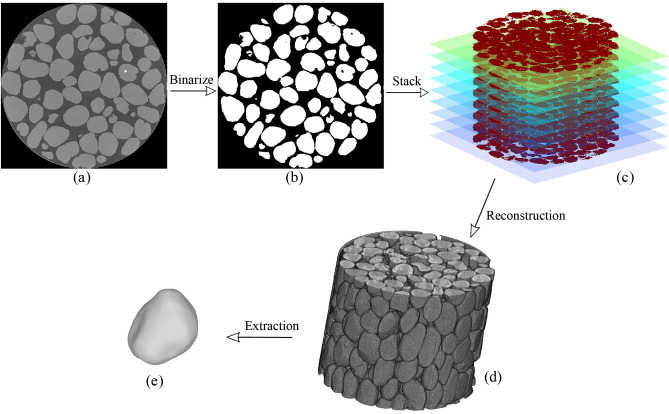JRMGE / Vol 13 / Issue 5
Isotropic compression behavior of granular assembly with non-spherical particles by X-ray micro-computed tomography and discrete element modeling
Nan Zhang, Ahmadreza Hedayat, Shaoyang Han, Runlin Yang, Héctor Gelber Bolaños Sosa, Juan José González Cárdenas, Guido Edgard Salas álvarez
Show More
a Department of Civil and Environmental Engineering, Colorado School of Mines, 1500 Illinois St., Golden, CO, 80401, USA
b Key Laboratory of Ministry of Education for Geomechanics and Embankment Engineering, Hohai University, Nanjing, 210098, China
c School of Civil and Resource Engineering, University of Science and Technology Beijing, Beijing, 100083, China
d Universidad Nacional de San Agustín de Arequipa, Arequipa, Peru
2021, 13(5): 972-984. doi:10.1016/j.jrmge.2021.04.005
Received: 2020-11-05 / Revised: 2021-03-17 / Accepted: 2021-04-14 / Available online: 2021-05-28
2021, 13(5): 972-984.
doi:10.1016/j.jrmge.2021.04.005
Received: 2020-11-05
Revised: 2021-03-17
Accepted: 2021-04-14
Available online: 2021-05-28
The particle morphological properties, such as sphericity, concavity and convexity, of a granular assembly significantly affect its macroscopic and microscopic compressive behaviors under isotropic loading condition. However, limited studies on investigating the microscopic behavior of the granular assembly with real particle shapes under isotropic compression were reported. In this study, X-ray computed tomography (μCT) and discrete element modeling (DEM) were utilized to investigate isotropic compression behavior of the granular assembly with regard to the particle morphological properties, such as particle sphericity, concavity and interparticle frictions. The μCT was first used to extract the particle morphological parameters and then the DEM was utilized to numerically investigate the influences of the particle morphological properties on the isotropic compression behavior. The image reconstruction from μCT images indicated that the presented particle quantification algorithm was robust, and the presented microscopic analysis via the DEM simulation demonstrated that the particle surface concavity significantly affected the isotropic compression behavior. The observations of the particle connectivity and local void ratio distribution also provided insights into the granular assembly under isotropic compression. Results found that the particle concavity and interparticle friction influenced the most of the isotropic compression behavior of the granular assemblies.
Keywords: X-ray computed tomography (μCT), Discrete element modeling (DEM), Isotropic compression, Particle surface curvature, Particle morphology
Show Figure(s)
Share and Cite
Nan Zhang, Ahmadreza Hedayat, Shaoyang Han, Runlin Yang, Héctor Gelber Bolaños Sosa, Juan José González Cárdenas, Guido Edgard Salas álvarez, 2021. Isotropic compression behavior of granular assembly with non-spherical particles by X-ray micro-computed tomography and discrete element modeling. J. Rock Mech. Geotech. Eng. 13 (5), 972-984.
Article Data
Author(s) Information
Dr. Nan Zhang
zhangnan@mines.edu

Nan Zhang is currently a research associate in the Department of Civil and Environmental Engineering at Colorado School of Mines (CSM). Prior to joining CSM, he worked as a postdoctoral fellow in Pacific Marine Energy Center (PMEC) at Oregon State University, USA, for one year. Dr. Zhang earned his BS and MS degrees of Water Resources and Hydropower Engineering and Hydraulic Structural Engineering from Chongqing Jiaotong University, Chongqing and Hohai University, Nanjing, China, respectively. Shortly after his graduation, he joined Oregon State University, USA, and earned his PhD degree of Civil Engineering specialized in Geomechanics. Dr. Zhang has a strong research interest in the development of computational models and experimental studies for the applications for both traditional and mining geotechnical engineering. Emphasis is placed on the main tracks as (1) numerical modeling of soil-structure interaction and offshore anchors, (2) granular mechanics, (3) mine tailings, and (4) geopolymer concrete. He has been participated in US National Science Foundation (NSF) and Department of Energy (DOE) projects and other projects from Peru.

